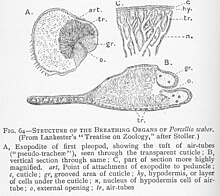This is an old revision of this page, as edited by Citation bot (talk | contribs) at 11:28, 27 September 2023 (Removed parameters. | Use this bot. Report bugs. | #UCB_CommandLine). The present address (URL) is a permanent link to this revision, which may differ significantly from the current revision.
Revision as of 11:28, 27 September 2023 by Citation bot (talk | contribs) (Removed parameters. | Use this bot. Report bugs. | #UCB_CommandLine)(diff) ← Previous revision | Latest revision (diff) | Newer revision → (diff)

en endopodite
ep epimeron
ex exopodite
lg pleopodal lung
pp pleopod
pr protopodite
pt pleotelson
ur uropod

Pleopodal lungs are an anatomical feature of terrestrial isopods and a component of their respiratory system. They are ancestrally derived from pleopodal gills, and they facilitate gas exchange on land. They perform a similar function as spiracles do in insects.
Pleopodal lungs are identifiable on woodlice as white patches on the lower 5 segments (the pleon) on the ventral side (underside). The number of pleopodal lungs vary by species – they may have up to five pairs, or only two pairs as in Porcellio laevis; a minority of species lack pleopodal lungs entirely.
References
- ^ "Woodlice: 'pleopodal lungs'". British Myriapod and Isopod Group. Retrieved 2020-04-24.
- Unwin, Earnest Ewart (1931). "On the structure of the respiratory organs of the terrestrial Isopoda". Papers and Proceedings of the Royal Society of Tasmania: 37–104. ISSN 0080-4703.
This Arthropod anatomy-related article is a stub. You can help Misplaced Pages by expanding it. |